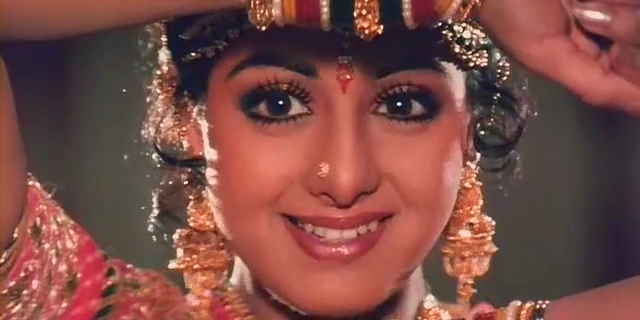
By now, anyone who knew who she was has heard about the sudden death of Bollywood superstar Sridevi. For those of us who grew up with her movies, the news was even more of a shock, because out of a gigantic movie industry which turns out over 700 movies a year, with just as many wannabes, hopeful stars and pretty-faced hopefuls, very few ever leave a mark in the way that Sridevi did.
There was something about Sridevi, I understood this even as a little girl. She appeared in some 300 movies across her career before taking a break in the mid-90s. The following are some of my favourite, and act as cultural landmarks in my childhood and teenage years.
The first Bollywood movie I remember loving was Nagina (1986). In it, Sridevi played a form-shifting female cobra who can’t resist dancing to the sound of a snake-charmer’s flute. Her famous snake dance became a favourite of mine, and as a child too young to understand how contact lenses worked, it seemed like magic to me that Sridevi’s enormous eyes were blue in the movie.
This was followed in 1987 with Mr India, another fanastical jaunt in which Sridevi played a snobby but well-meaning girl who of course eventually falls in love with Anil Kapoor’s broke-but-happy character. Along the way, there are orphans, a bomb hidden in a doll, a magic watch that turns you invisible and a bad guy with a pit of acid.
In it, Sridevi performs a dance sequence which either delighted or insulted all of Hawaii, but we didn’t care.
She also falls in love with Mr India after he rescues her, leading to this fantastic kiss scene.
I mean, who needs Stanley Kubrick with special effects like that?
In 1988 came the follow up to Nagina, Nigahen. As is always the way in Bollywood from the 80s, both of Sridevi’s character’s parents died in a car crash, one of those parents being the magical shape-shifting snake played by Sridevi. So now it’s down to the daughter (Sridevi again) to beat the bad guys with her magic snake dance and contact lenses.
But none of those movies even comes close to Chandni (1989), the epic love story which we all adored, the soundtrack from which I still listen to today.
Sridevi was an expert at iconic dance sequences,and Chandni is no exception. In this movie, she delivers one of her best performances to Mere Haathon Mein, the lyrics of which translate to “I have nine bangles on each hand”.
Naturally, within days of the movie releasing, replica outfits appeared at the weddings, the dance was executed at henna parties as quickly as you could nail down the choreography, and nine bangles on each hand briefly became the standard, even if in the movie dance sequence, Sridevi is actually wearing many more than that.
On a revisit, there is a lot wrong with the movie. Off the bat, Rishi Kapoor’s character, Rohit, a slick city boy, spots Sridevi’s character Chandni (moonlight) at a wedding and immediately professes his love by stalking and sexually harassing her.
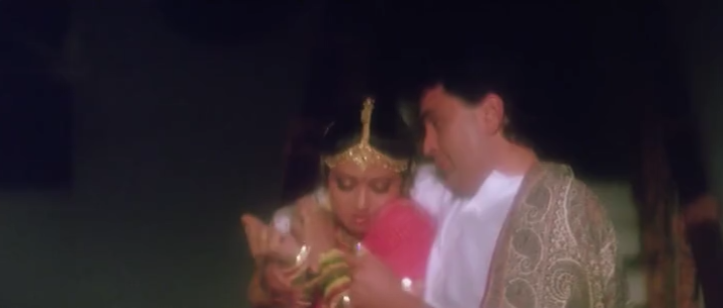
She responds in the only way possible for a 80’s Bollywood heroine by falling in love with him.
But there’s a problem. She’s from humble roots and Rohit’s family won’t have any of that. Like he cares! The movie goes on to set several impossible-to-meet standards for young men in the 80s. The sweaters for a start.
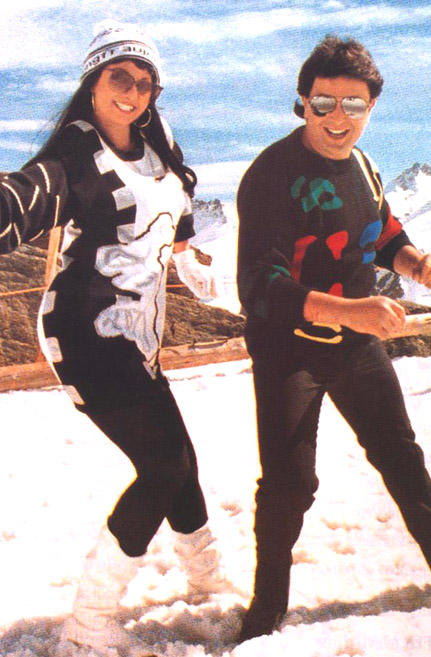
Then there are Rohit’s insane declarations of love, one of which is when he flies a helicopter over Chandni just so he can shower her with rose petals.
The moment he reveals to Chandni that he has plastered an entire room in pictures of her is forever preserved in the amber of Bollywood cinematic history. I honestly feel a little sorry for any young men who were on the dating scene at this time. I’m sure many a relationship fell apart because of a lack of a wall of pictures of you.
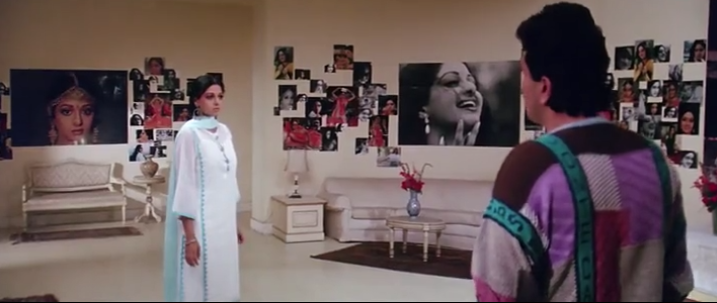
It’s the visual representation of falling in love, mirrored with the reverse sentiment when Rohit has an accident and tries to drive Chandni away, so invites her around to see how he has whitewashed over all her photos.
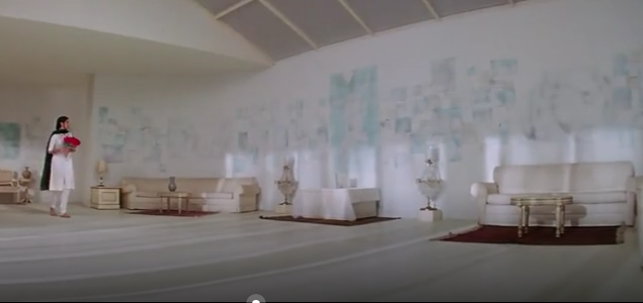
This movie was also among the first to heavily feature Switzerland in a fantasy honeymoon dream sequence, giving us the gold standard of 80s Bollywood cinema, the sari-clad heroine dancing in the snow, and everyone suddenly wanting to go to Switzerland on honeymoon.
The 90s saw Sridevi going from strength to strength. In 1991, she starred opposite Anil Kapoor (Viren) as Pallavi, and then Pallavi’s orphaned daughter Pooja when Pallavi and her husband are both killed in a car crash (naturally).
Again, it’s a slightly strange film which we consumed without question because we just didn’t question whacky Bollywood plotlines: Viren had fallen in love with the older Pallavi, but she loves someone else. When she dies, she leaves behind her daughter Pooja who Viren becomes the guardian of, providing all she needed but never visiting until Pooja grows up and then – gasp – she’s the spitting image of her dead mother! After some twists and turns, Viren and Pooja fall in love, which is not at all strange considering the 18 year age gap, guardianship etc.
This movie contained two iconic dance sequences, the first is Megha Re Megha.
And the second is Chudiyan Khanak Gayeen. This second dance sequence is one that we all tried to copy, and Pallavi’s yellow and blue outfit made a guest appearance at many a henna party for months afterwards. Fifteen years later, it was the dance I copied and performed at my big sister’s henna party.
Sridevi’s death will be greatly mourned in Afghanistan as well, thanks to her portrayal of a fierce Afghan woman, Benazir, in the lavish 1992 epic Khuda Gawah. Shot in Afghanistan, India, Bhutan and Nepal, The film earned her a huge fanbase in Afghanistan through its depiction of Afghan culture at a time when the country was no more than a footnote in the Cold War, and Sridevi’s Benazir was cheered for toppling the stereotype of the downtrodden and disenfranchised Afghan woman.
There were no fabulous dance sequences to copy from this movie, but it did give South Asia a taste of Afghan melodies with this song:
Bollywood is an industry spun out of dreams. It thrives on them. To this stage, Sridevi brought a kind of charm and natural comedic timing we’d not seen before. From the 50s through to the 70s, Bollywood was happy to feature strong female leads. That changed from the mid-70s onwards, and especially into the 80s, when female leads were universally beautiful, coy and always stumbling into some sort of disaster from which they needed rescuing.
Sridevi was one of the first actresses to break that mold. Of course, she appeared in plenty of demure roles too. But for the most part, the reason she is so loved, remembered and now mourned is because she was different. She’d deliver punchlines with perfect timing and danced like a dream. More often than not, she played three-dimensional characters who were clever and witty. Whatever she wore in a movie set the trend for the next few months, and even beyond her movie career. Just a few years ago, I bought a replica of a sari because I’d seen Sridevi wear it.
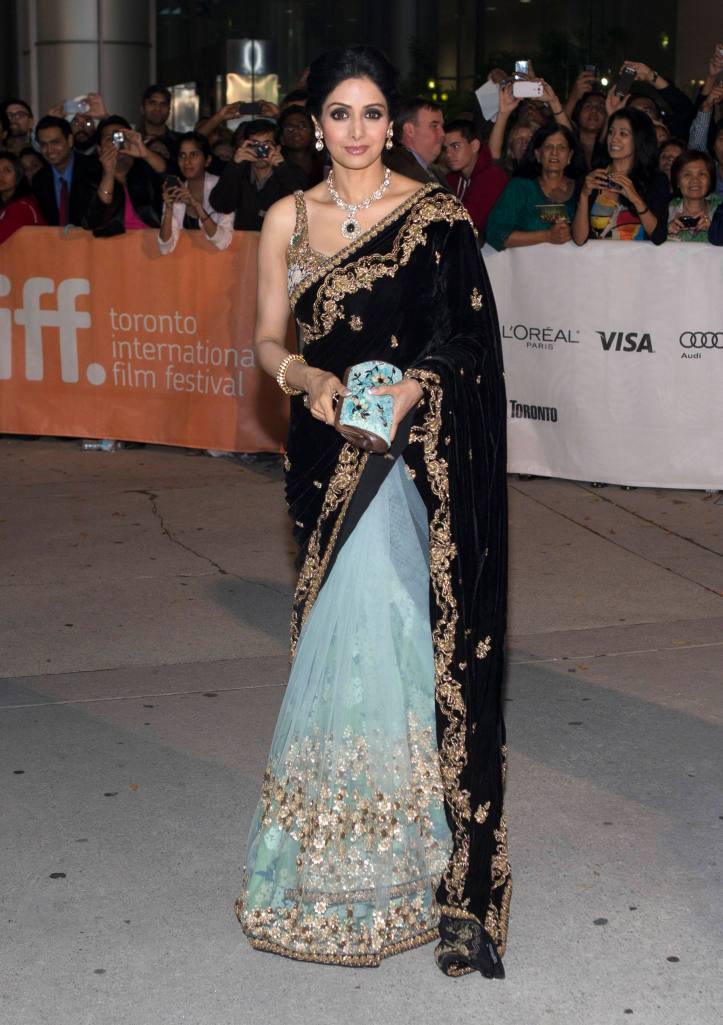
There was a kind of easy naturalness about her that made you feel like she could be your friend, even if that was all concocted for the silver screen, and watching her videos again today is a rare chance to see an hourglass figure which movie houses now seem to run screaming from, even in India.
Try as we might, we could never recreate those enormous eyes, and unlike on-screen Sridevi, we did not move in the world with a fan constantly blowing our hair into a billowing cloud away from our faces so that it didn’t get stuck to our cruddy 80s lipgloss.
In losing Sridevi so suddenly and at only 54, it’s not just Bollywood royalty that suffered a loss. Those of us who grew up with her movies feel like a part of our childhood just vanished. She left behind her on-screen self, which has stood the test of time well enough that we still risk wrecking our knees and tripping on our lenghas copying her peacock walk in Chudiyan Khanak Gayeen. We are older now, and we can’t make the same exuberant entrance that she did, her face popping on screen suddenly between a frame of her bangled arms in Mere Haathon Mein.
But we still try, and we still think we can pull the dances off, and that playful, crackling on-screen aura of Sridevi is part of the reason why we feel that way, and why nine bangles on each hand is a code that every 80s girl from the subcontinent will silently understand.